
Energy innovator aims to combine hydrogen production and fish farming
NAPOP will use heat and oxygen from electrolysis in recirculating aquaculture system
A small company in Norway has been awarded permits to produce 6,000 tonnes of fish in a recirculating aquaculture system (RAS) combined with a 6 MW electrolysis plant that will use green energy to split water into hydrogen and oxygen.
NAPOP (Not A Part Of the Problem) was founded in 2021 and rents and sells “energy station” generators and heaters - catalytic thermal combustion (CTC) units - that run on hydrogen. It is also seeking to build its own hydrogen production plants.
It will get a significant proportion of its energy for the combined RAS and hydrogen electrolysis plant in Åkrestrømmen, Rendalen in eastern Norway from solar power and is focused on ensuring that all value streams from the electrolysis process are utilised.
It has formed a subsidiary, VIRIDIH2, to realise the fish farm concept, called VIRIDIH2-PISCI.
Nothing wasted
NAPOP says that the oxygen produced in hydrogen production can be used directly as a raw material in fish farming, and so can heat from the electrolyser. As with the hydrogen production, all side streams from the fish farm will be utilised.
“We see VIRIDIH2-PISCI as a product based on a standard which can be adapted to different regions and locations,” said NAPOP chief executive Terje Paulsen.
“The first facility will be established in Rendalen (VIRIDIH2-PISCI Mistra) where we now have the necessary aquaculture licences. This will be followed by a facility that will be adjacent to the outlet of the Krøderen (a lake to the northwest of Oslo).
“Production of fish on land requires capacity for temperature regulation as well as large amounts of oxygen. The hydrogen will be used not least in our own technology which is used in NAPOP CTC heating centres as well as in our energy stations which use hydrogen for the production of electrical energy.”
Aage Bjørn Andersen, chief executive of VIRIDIH2, said: “We must think circularity in everything we do. It includes secondary resource management where the two solutions are about abolishing what we traditionally have called waste as well as emissions. It is precisely this that is the pillar of our strategy.”























































